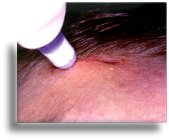
Indications for Use
Wounds that are suitable for closure with tissue adhesives include lacerations on the face, torso, and extremities that do not have any of several contraindications. Contraindications include location on the hands or feet, location over a joint or at a mucocutaneous junction, and heavy contamination.
In addition, skin adhesives should not be used in pregnant women or patients with a history of peripheral vascular disease, diabetes mellitus, or prolonged corticosteroid use, or on patients who have puncture wounds or bite or scratch wounds (animal or human in origin).
|
|
|
| Applying tissue adhesive to the wound | |
| Image taken from http://www.covenanthealth.com |
Application
Preparation for using a skin adhesive includes standard wound management steps: control of bleeding, assessment, irrigation, cleansing, and removal of any devitalized tissue. Depending on the depth of the wound, deep suturing may be necessary to eliminate "dead space" that could become infected.
To close the wound ,manually approximate the skin edges and paint the wound line with adhesive. Continue to hold the wound edges together for at least 30 seconds after applying the adhesive. No dressing is required, however, in some athletic settings, wound closure tapes or a butterfly bandage may be added to reinforce the wound and a dressing may be used to cover it.
Follow-up
The wound area should be inspected daily by the patient for signs of infection such as redness, swelling, warmth, tenderness, and drainage. The adhesive usually peels off within a few days after it is applied, depending on the site and the nature of the patient's activities. In most of these cases no follow-up will be required, but in some patients the nature of the wound and the patient's activities may suggest a need for a second look to make sure of proper healing. Clinical judgement can be the guide to follow-up.